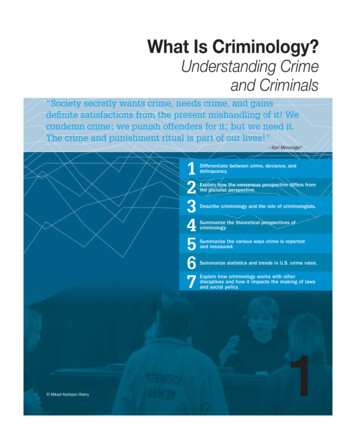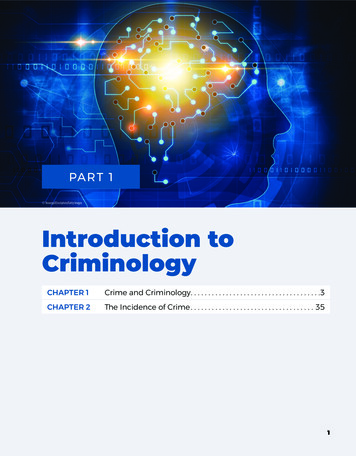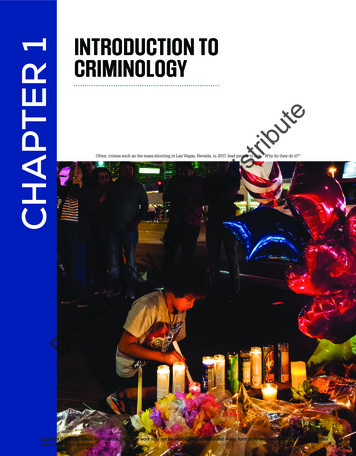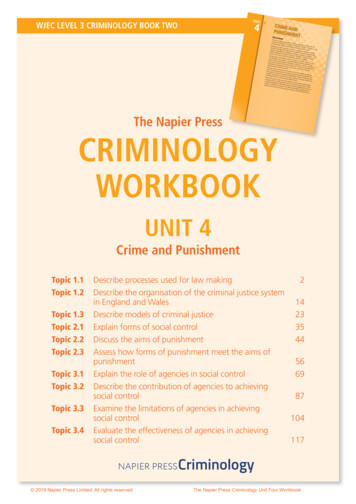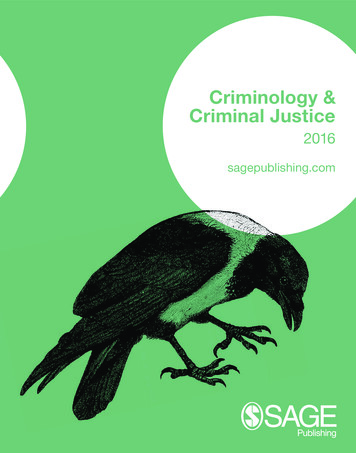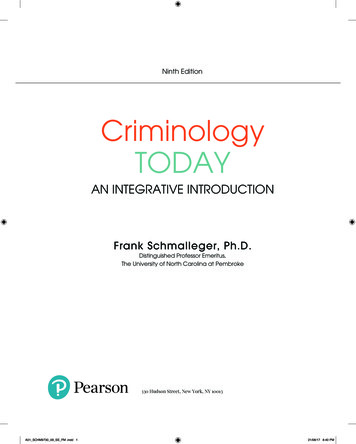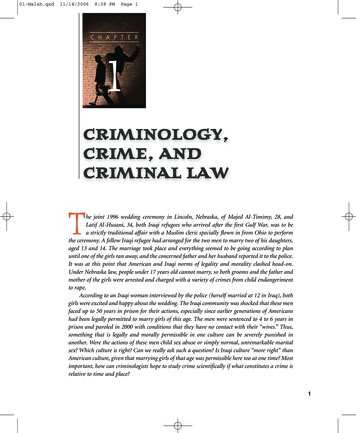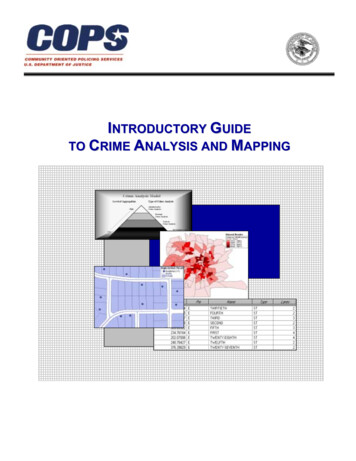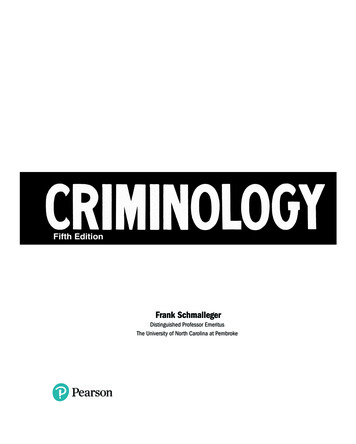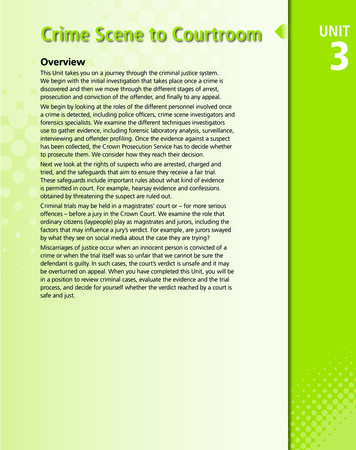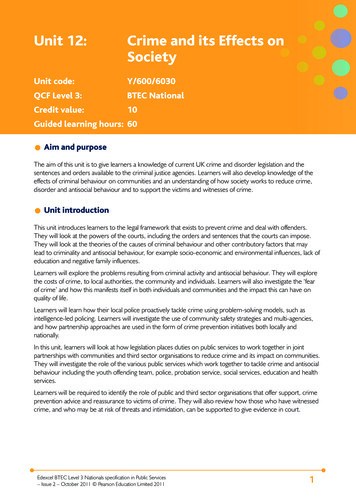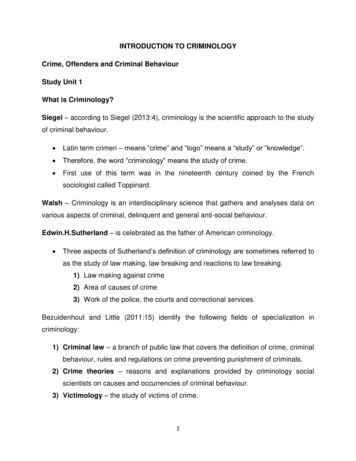
Transcription
INTRODUCTION TO CRIMINOLOGYCrime, Offenders and Criminal BehaviourStudy Unit 1What is Criminology?Siegel – according to Siegel (2013:4), criminology is the scientific approach to the studyof criminal behaviour. Latin term crimen – means “crime” and “logo” means a “study” or “knowledge”. Therefore, the word “criminology” means the study of crime. First use of this term was in the nineteenth century coined by the Frenchsociologist called Toppinard.Walsh – Criminology is an interdisciplinary science that gathers and analyses data onvarious aspects of criminal, delinquent and general anti-social behaviour.Edwin.H.Sutherland – is celebrated as the father of American criminology. Three aspects of Sutherland‟s definition of criminology are sometimes referred toas the study of law making, law breaking and reactions to law breaking.1) Law making against crime2) Area of causes of crime3) Work of the police, the courts and correctional services.Bezuidenhout and Little (2011:15) identify the following fields of specialization incriminology:1) Criminal law – a branch of public law that covers the definition of crime, criminalbehaviour, rules and regulations on crime preventing punishment of criminals.2) Crime theories – reasons and explanations provided by criminology socialscientists on causes and occurrencies of criminal behaviour.3) Victimology – the study of victims of crime.1
4) Criminal and deviant behaviour systems – risk assessment strategies thatexamine the patterns of criminal behaviour.5) Criminal justice – the study of agencies of social control that handle offenders.The Role of Criminologists Schmalleger (1996:12) maintains that a criminologist is a graduate who makes astudy of crime, criminals and criminal behaviour. According to Brown, Esbensen and Geis (2001) and Gibbons (in Bezuidenhoutand Little 2011:14) – on criminologist is someone whose professional training,occupational role and earnings or remuneration mainly relate to a scientificapproach to the study and anaylsis of crime phenomena and criminal behaviour.Beukman – (inBezuidenhout & Little 2011:14) considers the main functions ofcriminologists to be:1) Lecturing at Universities, Colleges;2) Researching at Universities, Colleges, or institutions such as the Institute of forSecurity Studies (ISS);3) Involved in community service and assisting victims of various violent crimes,domestic violence and victim support.Glick (1995:3 – 5) Fundamentally a criminologist‟s task is to – study – define – describe– explain – formulate policy directives in respect of crime, criminal behaviour andvictimization.Role players in criminology Academics (criminologists) Police officers Parole officers Correctional service officials Forensics The Discipline of Criminology2
Du Preez & Neser (1993:62) – the word “science” refers to knowledge (knowing) andindicates knowledge of a particular discipline that has been systematically collected.Johnson (1978:49 – 71) the following requirements have to be met if a subject is toqualify as an independent discipline:1) It must be its own object of study2) Identified as a unique and demarcated area of study3) Have its own procedures or scientific methodology4) Must have a study theoretical foundation5) Knowledge generated must be applicable to society6) Taught or practiced at an educational institutionFluctuating Parameters of CrimeThere are numerous examples of acts defined as crimes in one country being toleratedand even expected behaviour in another (walsh 2015:3): Nazi mass killing of Jews “Holocaust” Apartheid racial treatment of black people Abortion is a crime in Italy but not in the United States or in Britain Crime is studied from a number of perspectives Justice is not consistent – in SA horse racing is legal whereas dog racing (knownas greyhound racing) was banned in 1946 still a punishable offence. Criminal behaviour is defined by power relations of society Prevalent conditions of poverty Public tolerance Making new rules and regulationsVarious Approaches to the Study of CrimeGenerally speaking, criminologists study crime from two view points:1) The Juridical (legal) aspect;2) The non-juridical (social) aspect3
The Juridical Definition of Crime Focuses on actions that include a deliberate violation of the law of the State forwhich punishment may be imposed without justification or excuse (Bezuidenhout& Little 2011:15). Main focus is on wrongdoing. Before an act or omission may be defined as a crime, criminal law must regard itas such a suitable punishment must be in place. Hence the precept “no crime without law and no punishment without law”(Snyman, Middleton, Strauss, Geldenhuys, Albeit & Jordaan 1991:21ff).Juridical Elements of Crime1) The Act or conduct – a human act under the control of a human will.Three modes of action:1) Transgressing a prohibition2) Ignoring a prohibition3) Committing an act that has harmful consequences2) Wrongfulness – is an act which conflicts with the legal norm or prohibitionhowever, there are exemptions self-defence, emergency situations, victim‟sconsent and legal command.3) Guilt element – the culpable frame of mind in which a person commits awrongful act.Two forms of Culpa (accountable behaviour of the perpetrator:1) Deliberate intent (dolus)2) Negligence (culpa)4) The element of punishment – sentencing of criminal offenders in juridical termsonly punishable acts are considered crimes.The Non-juridical Definition of CrimeBezuidenhout & Little (2011:16) – Scholars believe that it is too simplistic to be guidedonly by criminal law when trying to understand human wrongdoing, criminal orunacceptable behaviour and the focus of criminology.4
Scholars broaden their search by seeking reasons of criminal behaviour. Consideration of the deviant behaviour of society. In a narrow juridical approach, adultery is not legally punishable. However, inbroad terms it is unacceptable or deviant behaviour which is frowned upon bysociety. The authors go on to stat that in order to understand deviant behaviour from anon-juridical perspectuive, the community has to be understood in its totality. Belief that narrow definitions of crime are short-sighted and depoliticizecriminology. Take into consideration of influential factors such as income, poverty social classand level education.Main Delineations of Social Crime(1) Crime as a violation of behavioural norms: Thorsten Sellin article “Culture, Conflict and Crime” Criminology focuses on the violation of social norms of behaviour as well,modern society, apart from being multicultural, consists of a variety of groups,each of which subscribes to certain norms, social values are standards set byparticular groups which may disadvantage others.(2) Crime as Social Harm: Edwin.H.Sutherland in his book “White Collar Crimes” published in 1949 arguescriminologists should study all illegal behaviour including civil justice.Crime as a Violation of Human Rights In 1975 the Schuendingers (proponents of the so-called “New Criminology”argued that any behaviour which violates an individual‟s human rights should beregarded as crime. These also include acts of imperialism, sexism and racism.5
Crime as a Form of Social Deviance Social deviations may be defined as behaviour that deviates from theconventional or commonly accepted norms and standards of society and forwhich are appropriate punishment exists. Deviance is defined by religion, political belief and etiquette, among others. Proponents of the non-juridical concept believe that criminologists should includeall the above elements in concept crime.Schools of Thought in Criminology(1) Classical Criminology Origins – During the late eighteenth century with the work of an Italianmathematician named Cesare Bonesano Beccaria and an English theorist,Jeremy Bentham (Eamon et al 2015) Works – Cessare Beccaria (1738 – 1794) book called “On Crimes andPunishment” published in 1764. Theory – Law must apply equally to all citizens and all found guilty of aparticular offence should suffer the same prescribed penalty. Pleasure-pain Principle – punishment should outweigh any pleasure to bederived from criminal behaviour but law must not be harsh and sever so as toreduce the greatest happening. Free will and hedonism where all humanbehaviour is purposive and based on the pleasure-pain principle.(2) Positivism Origin – Italian doctor named Cesare Lombroso Works – Cesare Lombroso in 1876 published the classic “Criminal Man”(1911), which earned him the dubious title “father of criminology”. Theory – Lombroso emphasized the biological basis of criminal behaviourarguing that the criminal is “born” that way and can be distinguished from noncriminals according to physical characteristics. Assumptions – three assumptions:6
(1) Physical characteristics – criminal behaviour is mainly attributed togenetic, biological and psychological features.(2) Belief – criminal offenders are driven by biological factors and psychologicalimpulses.(3) Mindset – intellectual, emotional skills and rational decision or exercise offreedom may be lacking. Principles – biological determinism and psychological determinism.(3) Critical Criminology Origins – Edwin.H.Sutherland coined the term “white collar crime”. Works – Edwin.H.Sutherland‟s famous works his book “White Collar Crime”. Theory – crimes of the working class are insignificant when compared tocrimes of the powerful.(4) Feminist Theory Origin – developed in the late 1960s and into the 1970s. Theory – An approach that challenges the male-centeredness of criminologyand tradition of “malestream” criminology fails to observe gender and sex roles. Principle – feminists see women as oppressed by both gender inequality andby class inequality ultimately they interpret female crime from a feministperspective. Liberal feminism – discrimination of women in social practices leads tooppression of women. Radical feminism – Patriarchy describes a power relationship inherent in thestructures which cause female subordination and exploitation. Maxist feminism – subordination of women is based on capitalist exploitationof their domestic role. Socialist feminism – “dual system theory” – recognizes the systems ofcapitalism and patriarchy to be separable but both influence oppression ofwomen.‟7
Black feminism – grounded on hierarchical and ideological belief that thesystem based on structure of domination prevalent personal, cultural,institutional and experiences of black women. Postmodern feminism – modern branch of feminism strives for equality for allgenders.(5) Rational Choice Origins – Italian “social-thinker” Cesare Beccaria founded the rational choicetheory Theory – The element of choice involves assessing the rewards and risksattached to committing a crime (Conklin 2004:228). The foundation of therational choice perspective is that crime is chosen for its benefits. Principle – the view that human beings choose to commit criminal behaviourafter weighing up the costs and benefits of an illegal act and can be deterredthrough the threat of punishment (Burke 2014:63) Rational choice perspective – the reward-risk approach influences offender‟sstrategic thinking.(6) Neo-classical School Origins – Originated from a school of thought that merely challenges theclassical position of absolute free will. Theory – The school of thought does not represent any schism. Principle – Neo-classicists specifically argue that free will can be inhibited bypathology, incompetence, mental disorder or other conditions that mitigatepersonal responsibility.(7) Critical Criminology Origins – Critical criminology is an umbrella term for a variety of theories. Works – In the US Edwin Sutherland invented the term “white collar crime”elsewhere in the U.K. in late 1960s and radical criminology also emerged.8
Theory – these are diverse theories such as conflict criminology, radicalcriminology, critical new criminology, radical human rights criminology, Marxist,neo-Marxist and left realist. Principle – critical criminologists propose that legitimate response to comemust be built upon a strategy of social empowerment. Edwin.H.Sutherland – it has been observed that there is a fine line between“entrepreneurialism” and “flair” and “sharp practice” and “fraud”.(8) The Social Milieu School of Thought Origins – Tarde, Guerry and Quetelet were proponents of this school ofthought. Theories – Two psychosocial Approaches: Social structure theory – reflects a fundamental faith in social system. Social process theory – most commonly attempt to explain how individualsbecome law violators by focusing in the social interactions or processesexperienced by individuals. Principle – the premises or points of departure from the social-environmentschool of thought may be summarised as follows: It is based on the juridical conception of crime. The main focus is on the criminal‟s social environment. It is assumed that improved social conditions will prevent crime. To all intents and purposes the criminal and the victim are ignored. There is no concern with punishment or rehabilitation.(9) Postmodern Criminology Origins – developed in the late 1980s Principle – postmodern criminology also focuses on universal factors thatcontribute to crime with its ultimate goal being to understand new ways ofknowing. Theory – Van Dijk (1998:8) includes the following universal facts ordeterminants that can contribute to the risk of crime and victimization:9
(1) Economic constraint and great differentiation in income.(2) Low educational qualifications;(3) A great number of firearms in circulation;(4) Rapid urbanization without the necessary infrastructure being availablesuch as housing, schools and health services;(5) Mere outgoing lifestyle;(6) Multicultural population;(7) A high alcohol and drug abuse rate;(8) A large population of young people;(9) Repeated victimization especially among young people with an outgoinglifestyle who live in big cities. Gottfredson‟s theory of self-control and crime as well as feminist crimeperspectives.Study Unit 2The Classification and Management of Crime:Key conceptsCrime – an intentional act in violation of the criminal law committed without legallyacceptable defence or excuse and penalized by the State.Code of crime list – this is used for the classification of crime in South Africa andconsists of 35 categories.Official crime statistics – statistical data compiled by the police courts and correctionsand routinely published by governments.Crime trends – the increase and decrease in crime rate such as murder, rape, burglaryand robbery over a specific period.Dark figure of crime (date deficient figure) – number of unreported crime.10
The Classification of Crime:Definition – Classification entails the arrangement of certain crime date/information intocategories.Purpose – so that we can predict whether this type of crime will increase and takepreventative measures to combat and prevent it.Classification – in the past South African Police used the following classifications thatis seven distinguishable categories:1) Crimes of violence – murder, attempted murder and robbery with aggravatingcircumstances.2) Social fabric of crime – rape, assault with intent to do grievous bodily harm andordinary assault.3) Property-related crime – breaking into residential and business premises, otherrobbery, stock theft, shoplifting theft from vehicle to other forms of theft.4) Commercial crime – fraud, counterfeit and embezzlement.5) Violence aimed at property – arson, malicious damage to property.6) Crimes heavenly dependent on police action for training – illegal possessionof firearms, drug-related crimes and driving under the influence.7) Crimes falling under robbery with aggravating circumstances – vehicle andtruck hijacking, robbery of cash in transit and bank robbery.Factors Influencing Criminal Activity:1.Effects of Alcohol on Behaviour: Research shows drinking releases fantasies of power and domination. Alcohol affects the individual‟s physiology, personality and social behavior. Pharmacologically alcohol is a depressant and that inhibits the functioning of thehigher brain centres. Alcohol is a brain-numbing depressant at law dosages it is actually a stimulantbecause it raises dopamine levels.11
Alcohol direct effects can help us reinvent ourselves as “superior” beings wherefear turns into courage, the withdrawn and timid (shy) become confidentand the timid become more assertive.2.The dark Figure of Crime (Data deficient figure):Unreported crimes – Walsh (2015:42) defines the dark (or hidden) figure crime as thatportion of the total crimes committed each year that never come to light.According to Singh (2011:105) and Eamonn et al (2015:32), the following are some ofthe reasons why people might not report a crime to the SAPS: A crime is sometimes seen as too insignificant to report, for example domesticabuse. A victim might not be sure how seriously their allegation will be taken by thepolice. People are not always aware that they are under threat or that a crime has beencommitted against them, for example fraud. The victim fears retaliation or repeat victimization. Victims might fear that their complaints will not be believed or that they will bedismissed as too trivial. The crime is considered personally embarrassing or shameful, for exampledomestic violence. There is a lack of trust in the competency in the SAPS. The victim may decide to take the law into his/her own hands and dispensejustice personally. The victim may not want to harm the offender – this is true of many householdviolence and molestation situations.3.Crime patterns and trends“Crime patterns” – is a specific pattern or occurrence in the incidence of criminalactivity which is influenced by various factors, such as the geographical area forexample the nine provinces in South Africa, age, gender and educational level.12
“Crime trends” – refers to the rise and fall in crime in a particular year. Thesefluctuations (rises and falls) are caused by factors such as economic situation in thecountry, educational level and age group.Crime trends according to categoriesCategories of crime indicate the type of crime committed. The government has rolledout the National Crime Prevention Strategy. Theft, robbery, robbery with aggravatingcircumstances, murder and rape are a few that are particularly problematic (high reportrates and difficult to prevent). Seven crimes which pose the greatest threat to citizensand the welfare of the country are namely:1) Crime with firearms – which has allowed violence to increase to a great extent;2) Organized crime – such as drug trafficking, smuggling and illegal immigrationwhich has risen sharply since South Africa‟s re-admission into the internationalcommunity3) White collar crime – fraud, money laundering, misappropriated and theft offunds;4) Sexual violence – crimes against children, rape, molesting and indecent assault;5) Gang violence – such as those prevalent in KwaZulu-Natal and the continuingtaxi wars;6) Vehicle theft and hijacking – causes insecurity among vehicle owners;7) Corruption – in the political, economic sphere and legal system.Crime trends according to region Crime trends differ from country to country, from region to region and fromprovince to province. South Africa is divided into nine provinces and the crime statistics show thatGauteng overshadows all other provinces in respect of crime. Increasedpopulation density results in an increase in potential offenders as well as victimsbecause there are more opportunities to commit crime.13
Rapid population growth, enhanced influx of economic refugees, fuels a processof accelerated urbanization, an increasingly younger and restless population atrisk and sufficient economic growth.Crime trends according to day, season and climate The warm summer months show an increase in reported crimes. Research hasshown that stress levels climb higher due to long-term exposure to extremetemperatures causing increase in violent crimes. In addition, young people commit more crime than any other age group andduring the long holiday season (November to January) they greater opportunitiesto commit and also to become victims of crime. During this same period, houses are left vacant because people are on holidaymaking them more vulnerable to property crimes.The first day of the month can also have an influence on the increase in crime. Considerthe following two reasons: Paying out of pensions People having extra money available which may relate to behavior associatedwith crime such as drinking, partying and gambling (Siegel 2009:45)Social class and crimePush factors - traditional observations show that poor and unemployed people havethe greatest incentive to commit crimes.Instrumental crimes – occur when desired goods which cannot be obtained byconventional means may be obtained through illegal activities, for example selling drugsor stealing valuables from people to obtain food.Expressive crimes – such as rape and assault on the other hand can be seen as ameans of expressing rage, anger and frustration against society.14
Use of firearmsFirearms, whether legl or illegal play a leading role in criminal activities. Nevertheless,Kleck and Gertz (inSiegel 2009:46) believe that the benefit of firearms as a preventiontool should not be overlooked. Advocates of firearm control see legislation as a positivestep towards curbing the ongoing crime wave in which firearms are used in theexecution of various crimes.Official and unofficial sources of crime informationKey ConceptsArson – the unlawful and intentional setting on fire of immovable property (Kemp et al2012:623).Assault – The unlawful and intentional application of force to another or inspiring thebelief of imminent force (Kemp et al 2012:623).Burglary/Housebreaking – Breaking into and entering a home or structure for thepurpose of committing a crime (Kemp et al 2012:626).Car hijacking – The forceful taking of another‟s motor vehicle by using violence or thethreat of violence to command possession of it.Questionnaire – A series of questions or items about a single subject or a series ofrelated issues that must be answered by a respondent.Self-report studies/surveys – the self-report study is a means of collecting informationabout aspects of an individual‟s personal experience such as involvement in offending(Walsh 2015:38).Victimization survey – this is a statistical survey that measures the amount, natureand patterns of victimization in the population (Walsh 2015:35).It is of significance to access or obtain the crime statistics from every region in thecountry for the following purposes:15
1) For crime prevention;2) Evaluation of crime prevention strategies or programmes;3) To implement a reliable and effective crime prevention system to control crime;4) Accurate reporting of crime;5) Eliminate misappropriation and manipulation of crime data;6) General public perception of the magnitude of criminal activity;7) Warn the members of the general public on the extent of crimes.Adolphe Quetelet, a Belgian statistician – compiled the first crime statistics. Crime statistics therefore constitute all the data and information on crime that arescientifically arranged and tabulated in order to offer a total picture of the crimeproblem.Three official crime information sources in South Africa, namely: The South African Police Service (SAPS); The court; and Prison statistics.Criminologists however utilize information that originates from the criminal justicesystem: Mass media contain vast amounts of crime coverage and comments e.g. news,films, internet and TV; Charities and voluntary organizations – such as NICRO have a long globalhistory of intervening in crime and deviance non-custodial sentencing of juvenileoffenders; International bodies – such as Interpol provide global and comparativecriminological data.Crime information according to official sources:Police Statistic16
Police statistics are compiled from records that describe how and when the crimewas committed, who committed it (offender), who the victim was and whatinjuries or losses occurred. In South Africa, polices statistics are provided by the Crime Information AnalysisCentre (CIAC). Provincial offices in the nine provinces of the country issue monthly reports on allcrimes and this information is then consolidated, processed and interpreted bythe centre. These statistics do not reflect the real extent of crime in South Africa because of: Poor public reporting or lack of cooperation; Poor police investigations consisting of impartiality and incompetence; Slow administration of justice; Under-reporting by victims Inaccurate media reports;Judicial and Prison Statistics: Statistical figures from Courts and Department of Correctional Services areconsiderably lower than those extracted from police statistics. Once crime has been identified the National Prosecuting Authority must decidewhether to prosecute the offender. This decision is based on the evidential value and prospects of a successfulconviction also available witnesses and police investigations are crucial factors. Official statistics indicate that fewer criminals exit the criminal justice system thanthose who enter which is expressed by a decrease or decline in crime figures.A decline in crime figure is represented by the following diagram:Funnel of the Criminal Justice SystemBroad communitySerious crimes17
Committed crimesReported arrestCharged guiltySentencesParolePrisonsReleasedA report published by the Law Commission which involved almost 16000 police docketsprovided the following information:Throughout the country on average only six out of every 100 violent crimes reported tothe police end in conviction: Statistics show that approximately 11% of all reported murders end in aconviction. Up to about three quarters of reported cases of murder, rape and robbery withaggravating circumstances have still not been tried two years after arrest. The rate of murder and rape cases is considerably higher in other countries suchas England and Wales. rbate/contribute to the problem. Police work with insufficient resource and heavy load of cases. The public cooperation is an important role through witnesses.18prosecutors
Shortcomings of official crime statistics: The main limitations may be summarized as follows: Only reported crimes feature in official crime statistics. Crime statistics are defective since they are expressed in relation to the totalpopulation. Some crimes are more likely to be reported than others. Police acumen may influence crime reporting. Changes in legislation, technology and police manpower may influence crimefigures. Socio-economic changes may influence the volume of official crime recorded.Crime information according to unofficial sources of crime information:Information according to victim surveys: Since the 1970s many countries have established official crime victimizationsurveys. This is a key method of addressing the “dark figure” of unreported crimes. Victim surveys investigates about peoples‟ attitudes and criminal justice system. Corruption in the criminal justice system is a major concern for surveyrespondents. The United Nations Interregional Crime and Justice Research Institute (UNICRI)has been undertaking victim studies since 1989. Whites are the biggest victims of crime especially in property crimes. Black and coloured people were more often victims of violence than whites andAsians. The incidence of assault with aggravating circumstances, violent attacks ontrains and rape or attempted rape was highest among blacks while colouredswere especially vulnerable to molestation in public. Research indicates that victimization, crime and violence are commonexperience for many young South Africans. Young people experience assault nearly eight times the adult rate.19
Young people are exposed to theft at five times and robbery at four times theadult rate (Pelser 2008:2)Limitation of victim surveys:1) Dark Figure – some drawbacks in unofficial sources include the “dark figure”which refers to those crimes that are committed but not reported to the police.2) Unidentified victims – the general inability to tap information of victim profiles oridentity.3) Undetected criminal activity - Many crimes occur in hidden and secluded areassuch as the corporate boardroom, the financial marketplace, on the internet ordirected against the environment (conservative crimes) therefore there is noresearch, no theory, no control, no knowledge or statistics.4) Uncollected data – tendancy to ignore different cultural perceptions affecting therespondents.5) Inadequate facts – Victims forget important facts of events which took place.6) Voiceless victims - some victims don‟t have confidence in the criminal justicesystems or are silenced.7) Under-reporting of crimes – lack of witness reports.8) Repetitive story telling – occurs where the same offender is identified hencevictim surveys reflect the number of crimes not the number of offenders.Self-report studies/surveys Self-report studies are surveys conducted by anonymous respondents, withoutfear of disclosure or arrest are asked to respond confidentially to any violations ofthe criminal law that they have committed. Anonymity and confidentiality are guaranteed. Self-report items aim to measure attitudes, values, personal characteristics andbehaviours. Data obtained from these reports can be used to test theories and measuringattitudes towards crimes.20
Researchers can correlate a variety of characteristics of respondents with theiradmitted offences that go beyond the demographics of age, race and gender. Criminal mindsets such as impulsiveness, empathy and sensitive seeking, peerpressure influences can be weighed.Problems Scope of questions is limited; Only directed towards pett
2 4) Criminal and deviant behaviour systems – risk assessment strategies that examine the patterns of criminal behaviour. 5) Criminal justice – the study of agencies of social control that handle offenders. The Role of Criminologists Schmalleger (1996:12) maintains that a criminologist is a graduate who makes a study of crime, cr
